Industrial robot controllers have become the backbone of modern manufacturing, allowing factories to streamline production while maintaining high precision. These controllers ensure robots perform tasks accurately, from assembling components to handling heavy materials. Similarly, a forklift speed controller enhances warehouse safety and operational efficiency by regulating vehicle movement. Together, these technologies revolutionize industrial workflows.
Industrial Robot Controllers Driving Precision and Productivity
Industrial robot controllers are sophisticated devices that coordinate robot movements and task execution. By programming these controllers, manufacturers can achieve consistent output quality while reducing human error. They provide real-time monitoring, enabling operators to adjust parameters on-the-fly for optimal performance. The adaptability of industrial robot controllers also makes them suitable for diverse sectors, including automotive, electronics, and logistics.
Enhancing Warehouse Safety with Forklift Speed Controller
A forklift speed controller is essential in environments where safety and efficiency are critical. By controlling acceleration and top speed, these devices minimize the risk of accidents, especially in congested warehouses. Operators can focus on precise material handling without worrying about sudden speed changes. Integrating forklift speed controllers into warehouse operations improves both productivity and staff confidence.
Key Benefits of Using Advanced Controllers
Implementing industrial robot controllers and forklift speed controllers offers numerous advantages:
- Improved precision in repetitive tasks
- Reduced operational errors and downtime
- Enhanced safety for human operators
- Energy-efficient operation and cost savings
- Real-time monitoring and adjustment capabilities
- Integration for Seamless Industrial Workflow
Combining industrial robot controllers with forklift speed controllers creates a synchronized operational environment. Robots handle repetitive or heavy-lifting tasks while forklifts, controlled for optimal speed, transport materials efficiently. This integration minimizes delays, reduces damage risks, and enhances overall throughput. Industries adopting both solutions report faster project completion and lower operational costs.
Future of Automated Control Systems
The future of industrial automation relies heavily on the continuous development of controllers. Industrial robot controllers are evolving to include AI-assisted decision-making, predictive maintenance, and remote operation capabilities. Forklift speed controllers are also advancing, offering adaptive speed management based on load weight and floor conditions. Businesses leveraging these technologies stay ahead in competitive markets.
Choosing the Right Controllers for Your Operation
Selecting the proper industrial robot controllers and forklift speed controllers depends on the complexity of tasks and operational scale. Factors such as load capacity, precision requirements, and integration with existing systems must be considered. Proper training and maintenance further ensure that these controllers provide long-term benefits, maximizing both safety and productivity.
Conclusion
Industrial robot controllers and forklift speed controllers are indispensable for modern manufacturing and warehousing. Their ability to combine precision, safety, and operational efficiency makes them critical tools for businesses aiming for excellence. Companies looking to optimize their industrial operations can find innovative solutions and detailed guidance at seer-robotics.ai.

